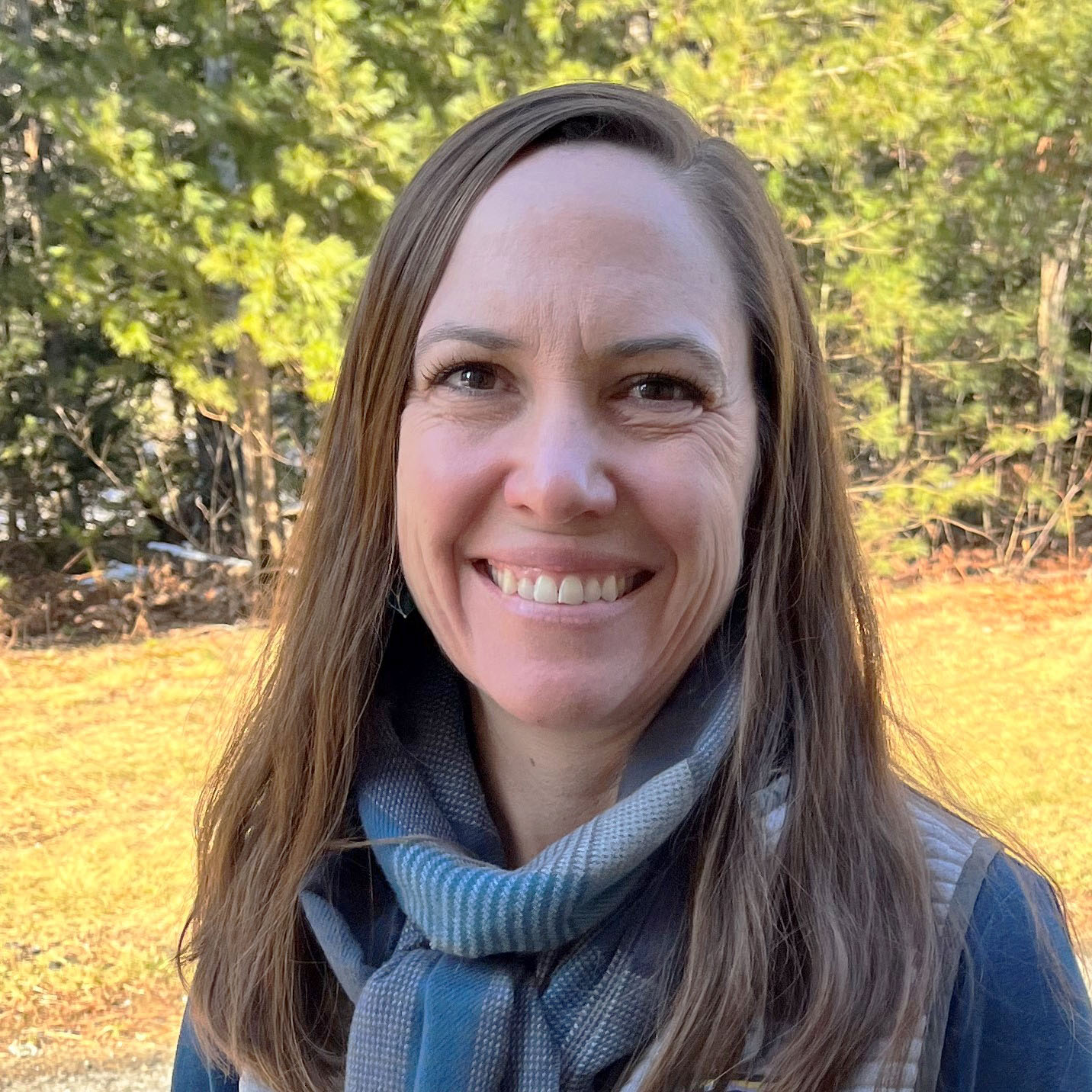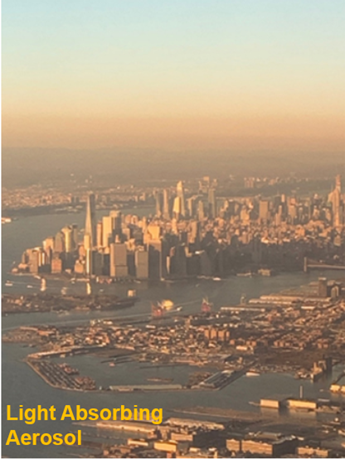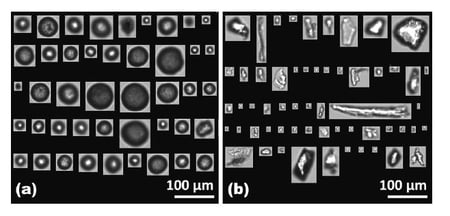
The Alexander Laskin Research Group at Purdue University is a "multi-disciplinary experimental group with research interests in the areas of Analytical and Physical Chemistry of airborne and aquatic environmental particles, driven by the overarching goals of understanding their impact on the environmental chemistry, the air pollution, and the Earth’s climate."
The environmental particles studied by the Alex Laskin group can have natural and anthropogenic sources including oceans, deserts, volcanoes, transportation emissions, aviation, fire retardants, explosion disasters, and even household cooking. These particles often have multiphase chemistry, meaning they can change shape, size, and chemical composition. Particles below 2.5 µm are considered respirable and are able to enter the lungs, bloodstream, and brain.
Pictured here: Air pollution event over the New York City metropolitan area (photo by A. Laskin)
With the goal of understanding how these particles affect our climate, the group concentrates their research efforts on three areas:- Development and applications of new analytical methods for chemical characterization of environmental particles
- Chemical imaging and molecular-level studies of field-collected particles
- Laboratory studies of multi-phase chemistry of particles and interfaces
The Alex Laskin group's lab focus is on particles ranging from 10 nm - 1 µm. Historically they have used Transmission Electron Microscopy (TEM), Scanning Electron Microscopy (SEM), and Scanning Transmission X-Ray Microscopy (STXM) to obtain particle images. In order to use these methods, the particles have to be collected and deposited on substrates and then analyzed at specific offsite facilities. Mass Spectrometry can be used for chemical information and composition but not to look at individual particles. In order to expand their in-house analysis capabilities, the group recently acquired a new FlowCam Nano instrument that will allow them to image colloidal particles 300 nm and larger suspended in aquatic systems, without deposition on a substrate.
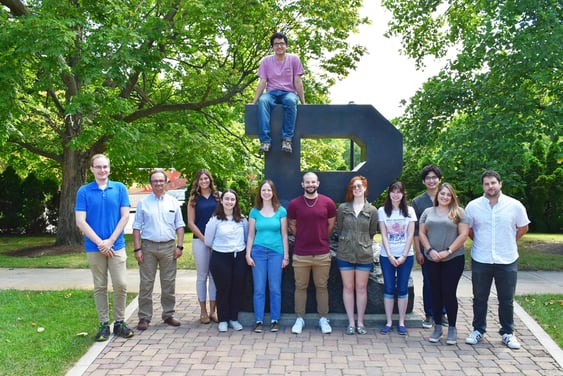
New FlowCam Nano users: the members of Purdue's Alexander Laskin Research Group
One of the group's current projects benefitting from FlowCam Nano sample analysis is the study of the photocatalytic transformations of metal (Fe3+/Fe2+) - organic mixtures in an aquatic environment. Environmental sources of Fe3+/Fe2+ (iron) include dust, windblown mineral dust, and fly ash from coal and wood burning. The molecular-level composition and extent of the photochemical reactions occurring in the condensed phase are still poorly understood for this chemical system.
To study the properties of these particles, the group experimentally exposed an Fe(III)-Citrate proxy to varying durations of light and then characterized the molecular-level composition of the resulting mixtures at the different time intervals. During their research, they noted the presence and growth of insoluble colloids formed in the aqueous solutions requiring additional measurements for analytical characterization. They attempted to use Dynamic Light Scattering (DLS) to characterize and quantify sizes of these particles, but ran into issues related to low particle concentration and the polydisperse nature of their samples. They decided to investigate FlowCam as an alternate particle analysis technique. FlowCam Nano allowed them to overcome the limitations of DLS while also collecting particle images and showing clear differences between unreacted samples and photoreacted samples with varying durations of light exposure in the native state of the solution.
Below is FlowCam Nano data produced from the group's Fe(III)-Citrate proxy samples - first the unreacted sample, followed by a sample that had been exposed to light for 80 minutes.
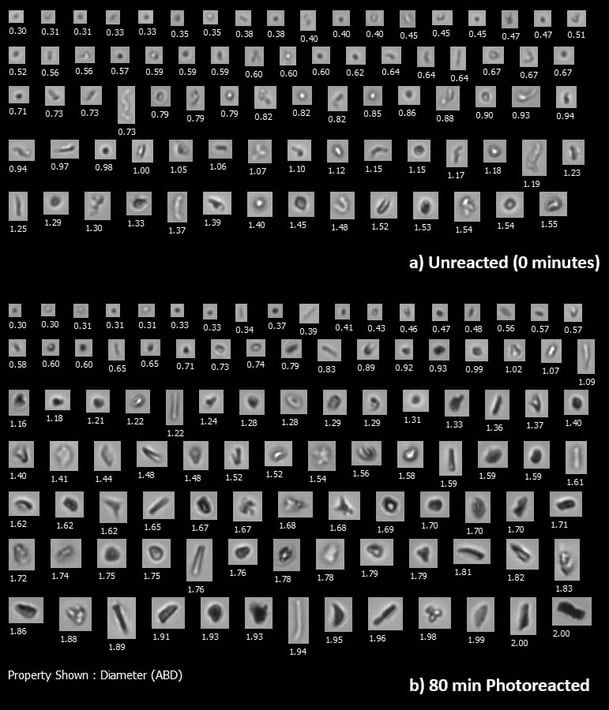
(a) Unreacted sample containing semi-solid colloid particles. (b) 80 min photoreacted sample.
According to data produced using FlowCam Nano, the representative images reveal relatively small and round colloids in the (a) unreacted Fe(III)-Citrate sample which are characteristic of inorganic Fe(OH)3 precipitates/colloids. On the other hand, the (b) 80 min photoreacted revealed significantly larger organic colloids than the latter. The Alex Laskin group converted the FlowCam Nano imaging data into the relevant size distribution to quantify the changes in the particle sizes in the form of the lognormal mass-size distribution. Based on the calculated size distribution, the colloids appear to shift to larger particle sizes and higher concentrations under long exposure to 365 nm light in the 80 min case. The results suggest that under extensively photoreacted Fe(III)-organic systems in aqueous solution, mass growth of organic colloids occurs.
Read the full results of the study here:
The results of this study may imply additional absorption and scattering of UV-Visible light with implications to the radiative budget of the atmosphere. The data collected is important to further our understanding of the multiphase chemical processes of atmospheric aerosols and their effects on the warming and cooling of the atmosphere.
To learn more about how FlowCam Nano works to image and analyze particles in the submicron size range, follow the link below:







